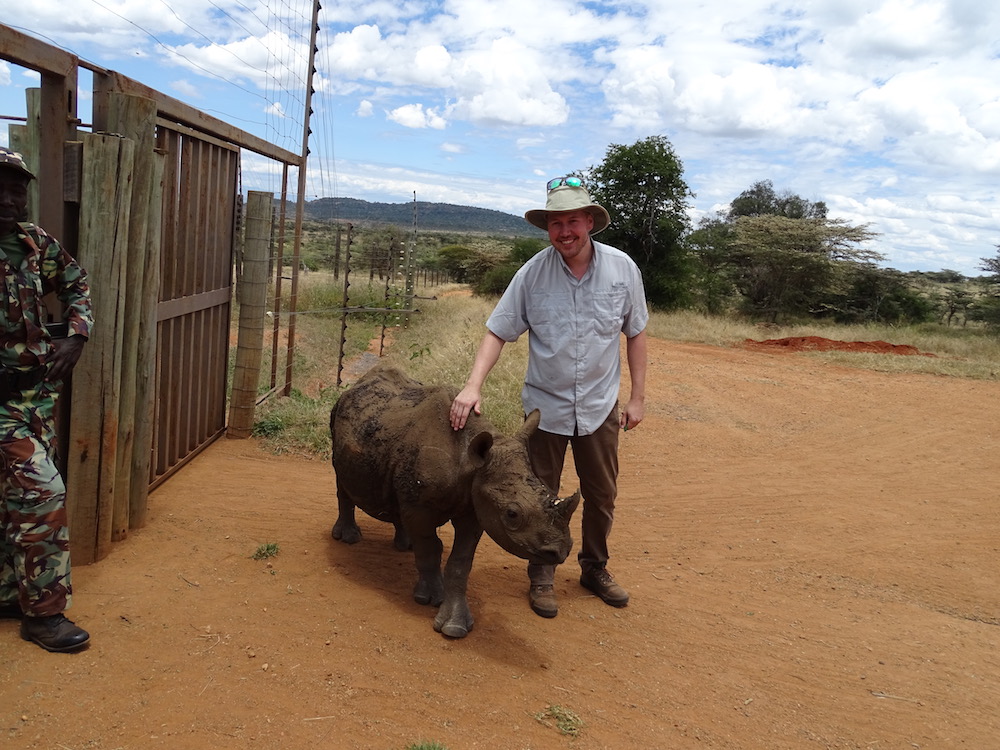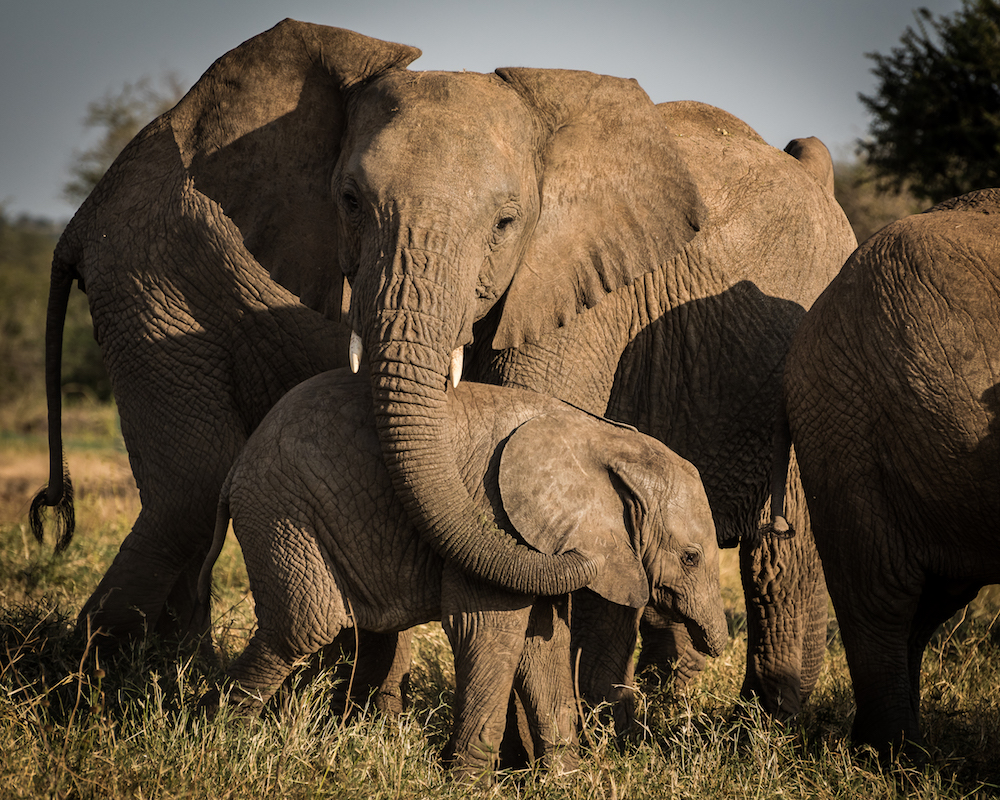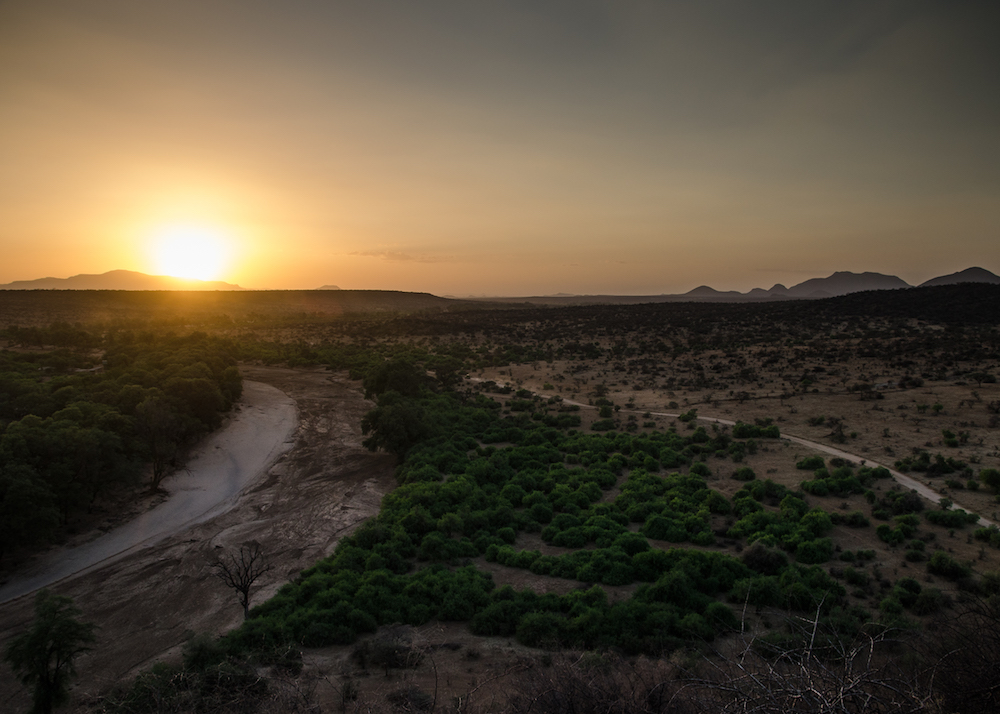Look more closely, and you'll see that each of the giraffe's delicately-penned spots reveals a different pattern of lines, dots, or swirls: a sort of census of the animal's microbiome laid out in ink.
"This is an artistic rendering of our research," explains Kartzinel, now IBES fellow and Assistant Professor of Ecology and Evolutionary Biology here at Brown. "The molecular, the microbial, and the mega—all in all the same intellectual space."
It's an apt description of the work his lab does, using manipulative field experiments and genetic analysis to better understand how species are connected to each other in the wider web of life, and how those connections change from place to place.

His work is revealing nuances in many conventional ideas about how species interact, especially in regard to antagonistic or predator/prey relationships.
"Ecologists have often treated interactions between species as if they are an immutable property, like: the lions always eat the zebras; but that doesn't jive with how we think nature really works," says Kartzinel. "We know that lions are more likely to eat zebras in some places than others, and some zebras may be at greater risk than others, but these differences can be really hard to quantify. The problem is that we need to understand who eats what in nature if we're going to conserve it effectively."
Thus far, Kartzinel's work has shown very clearly that animal feeding behaviors can be more complex and important than many people or ecological theories may appreciate.
Findings from the field
On a recent field excursion to Kenya, Kartzinel recalls explaining the purpose of his trip to a customs agent. ‘I'm here to figure out what elephants eat,' he remembers saying.
"She said, ‘You didn't have to fly to Kenya. I can tell you: They eat trees.'"
He chuckles as he acknowledges this well-known fact, and explains that his lab is using DNA-based tools to answer a question that is deceptively simple: What kinds of trees do elephants eat?
"Savanna ecologists have known for a long time that sometimes elephants eat trees, sometimes they eat grass, and sometimes they eat a mix of both," he says. "We can figure out exactly which type of tree, and exactly which type of grass. What that allows us to do is figure out how elephants are likely to impact vegetation, and what other herbivores they are likely to compete with. And then we can use experiments to test our predictions."

"This is one way that our work is helping wildlife conservancies figure out ways to protect species like elephants, giraffes, and black rhinos in the same place," he says, "even though these species might compete for food."
And while the Kartzinel Lab works to understand the precise details of these patterns of interaction, they sometimes come up with findings that are brand new to academic ecologists.
"Some of the surprises we've found turn out to be things that have been well-known to traditional pastoralists for many centuries," says Kartzinel.
For instance, the Western perspective on ranching professes that 'cattle eat grass.' But when Kartzinel began to analyze cow dung from the Kenyan drylands, he realized that this story is, at best, incomplete.
"They're eating a lot of plants that aren't grass too," he says. "I started to learn from the teachings of the pastoralists that when cows eat some of these other plant species, they may have better milk production and growth. So this is a case of Western scientists ‘rediscovering' traditional knowledge."
Conservation challenges
Like many Institute scholars, Kartzinel's work aims to place the needs and dignity of the people living in an environment on a par with the health of local species and ecosystems.
In Kenya, for example, his lab is working with researchers, landowners, and pastoralists to devise ways of sharing and using land that enhance the productivity and prosperity of both human and animal populations.
"In many places, some of the biggest challenges for promoting wildlife conservation and advancing human livelihoods involve making sure everyone has enough to eat," he says. "That includes the people, their livestock, and the wildlife that exist alongside of them."
As Kartzinel explains, most of Kenya's charismatic wildlife exist outside of the public National Parks—and traditional pastoralists, farmers, and ranchers are growing crops and raising livestock in these same areas.
"Our work can help people make decisions about where to take their livestock by giving them a better awareness of their impacts on vegetation and the needs of wildlife," he says. "This way, we can contribute to the mission of local and international conservation organizations that are working on the ground to find more equitable and sustainable solutions to human-livestock-wildlife coexistence."
Technology and teamwork
Rapid advances in DNA-sequencing technology have enabled the lab to generate new findings and make enormous headway on such real-world applications; however, limitations still exist. For instance, as Kartzinel explains, it still takes a few months before an analysis of field samples can tell the group anything about how species are behaving in the real world.

"There's a gap between the pace of research and the pace of conservation decision-making, and I really want to close that gap," he says. "I think some of the most exciting advances will come in the next 5 or 10 years. That's when we'll be able to inject useful information into the decisions that people face in real time."
Kartzinel credits much of his lab's innovation and intellectual capacity to a diverse group of students and postdocs.
"Our team includes people who are molecular biologists first and foremost, and we have field and experimental ecologists who are still learning how to use pipettes," he says. "Creating the conditions for this type of cross-pollination to succeed is hard work, but there is a payoff where groups of people commit to applying their unique strengths to shared interests; there is creativity in collaboration."
Indeed, the Kartzinel Lab has no shortage of talent. Just this year, two undergraduate mentees are on their way to Fulbright experiences.
Kartzinel is clear about the enormity of the questions his lab is trying to answer, and the necessity of using different perspectives to generate evidence that can then be put into practice.
"We are making conservation decisions at big scales and sometimes in ways that are very consequential for people and for endangered species. And we're making a lot of those decisions based on assumptions about the web of life that we've never really tested," he says. "Ecologists are smart people and very observant, and we're probably getting a lot of things right. But the stakes are high, and our science has to become more precise and more predictive."
The Kartzinel Lab's method of using molecular biology to inform conservation decisions is at once novel and crucial. But Kartzinel thinks there's more to the task than necessity. For him, these questions are fascinating—simply for their own sake.
"I can offer you lots of reasons why it's important that go beyond my own childish desire to have fun and learn about the world," he laughs, "but I don't think that should be a requirement. This type of research can be really important—but if it's just interesting, you know, that's alright too."